Pickup Truck Nation
What the Dominance of Pickup Trucks in U.S. Car Sales Means for a Changing Automotive Market…and A Changing America

Introduction
Every once and a while, a visual just grabs your attention - and simply won’t let it go! That happened to me when I saw an amazing infographic put together by the data analysts at Visual Capitalist. Now, as a strategic management professor and consultant, the auto industry is one area of the economy that you simply have to pay attention to - as it is perhaps the one consumer product category, outside of the absolute “basics,” like groceries, medicines, clothing, and real estate, that impacts everyone in one form or fashion - on what we drive, on how much we pay each month for our car (and insurance, and gas, and maintenance, etc.).

Transportation is a basic need, and for most Americans who don’t live in one of about 10-15 major cities where the close proximity of almost everything and mass transit make a car more of a luxury, a personal vehicle is an absolute necessity for the rest of us. Having lived and worked in the South all of my life, one can appreciate how very much pickup trucks are a staple of Southern life, work, and culture. Today, however, pickups have become more and more central to the American existence and identity, and the numbers back that up! The most recent data on new vehicle sales in the United States shows that we are indeed fortunate to be largely a nation of car owners, or increasingly, truck owners. In this article, we explore this phenomenon - and what it means going forward for the auto industry - which is increasingly becoming what seems like the pickup truck industry - and more.

Pickup Truck Nation
What number made me almost spit out my morning coffee all over my MacBook screen and cost me far more than that cup of joe? It was this graphic put together by the data analysts at Visual Capitalist. Figure 1 (Best Selling Vehicles in America by State, 2022) below replicates the graphic that the firm featured in its weekly subscriber newsletter that almost cost me a grand in Mac damages!
Figure 1 - Best Selling Vehicles in America by State, 2022
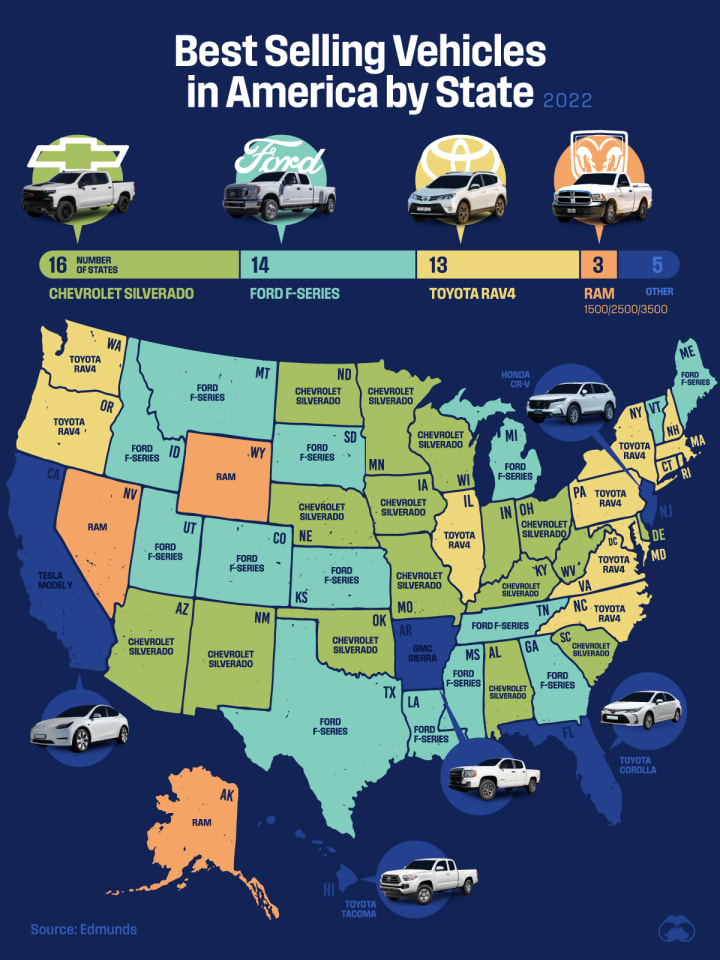
Source: Visual Capitalist, The Best Selling Vehicle in Every State, October 2023 (Used with permission).
The Visual Capitalist data journalists constructed a simple infographic that pictured which vehicles were the top sellers in every one of the 50 states, based on 2022 sales data. As you can see in this infographic, Chevrolet (part of General Motors, of course) and Ford are “duking it out” for sales superiority, being the top-selling vehicles in 16 and 14 states respectively. Dodge (a unit of Stellantis, a company few Americans could identify until very recently when the United Auto Workers' strike against the “Big 3” American automakers thrust it into the limelight, with many, including newspeople, quizically and comically trying to get the name right and not call the company by its former name, Chrysler, which is still a major brand for it) came in a very distant third, leading in just 3 states. When one combines the 34 states in which American-branded pickups (adding in Arkansas, where the GM-produced GMC Sierra is the top-selling vehicle) with Hawaii (where the Toyota Tacoma pickup leads the way in unit sales), this leads to a really astonishing number: In over 70% of America (geographically-speaking), pickup trucks are the most sold vehicle. Period - full stop!

To put this in context, let’s delve just a bit into the most recent new vehicle sales numbers available (from the calendar year 2022), to see just how profound the shift in the auto industry has been over the past decade or more. Last year (2022), according to state registrations, depending on who is doing the counting, there were between 13.6 and 13.9 million new vehicles sold in the United States. When broken down by state, as you can see in Table 1 (New Vehicle Sales by States, Ranked [2022]), sales volume by states closely mirrored state populations. Thus, not surprisingly, California, Texas, Florida, and New York led the nation in new vehicle sales.
Table 1: New Vehicle Sales by States, Ranked (2022)
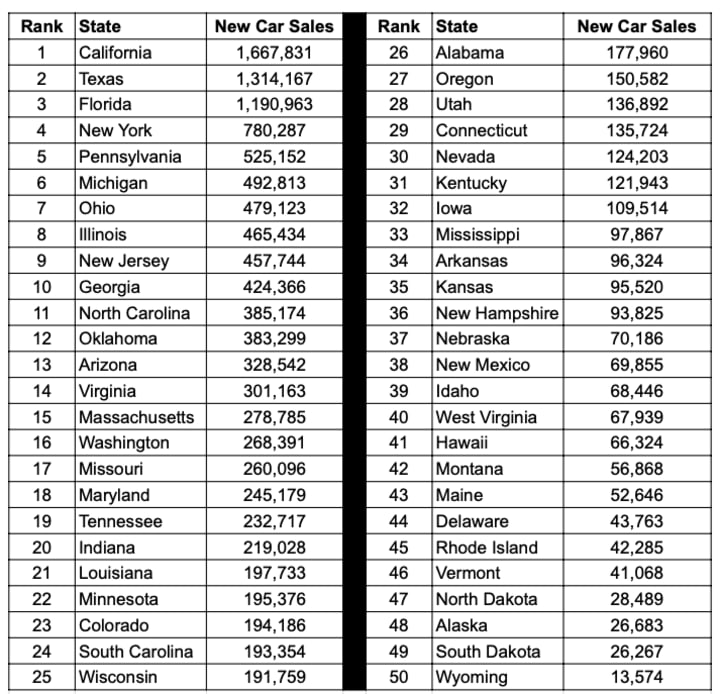
Source Data: F&I Tools, Car Sales by State, 2022, August 2023.
The real story, however, lies in precisely what - and more specifically, what kinds of - vehicles are being sold today. Table 2 (New Vehicle Sales by Make and Model, 2022) lists all vehicles that had more than 100,000 units sold last year (2022). As you can see, 33 different vehicle types sold more than that benchmark number - with pickup trucks leading the way. The top-selling new vehicle was the Ford F-Series pickup, with sales totaling over 650,000 units. The Ford truck was closely followed by the Chevrolet Silverado pickup (at over 500,000 units) and the Dodge Ram pickup (at over 450,000 units). So, the top 3 selling new vehicles in the United States- and likewise, 4 of the top 6 and 5 of the top 12 - were pickup trucks! In fact, just between the four most popular pickup truck models (including the GMC Sierra), right at 2 million units were sold last year!
Table 2: New Vehicle Sales by Make and Model, 2022
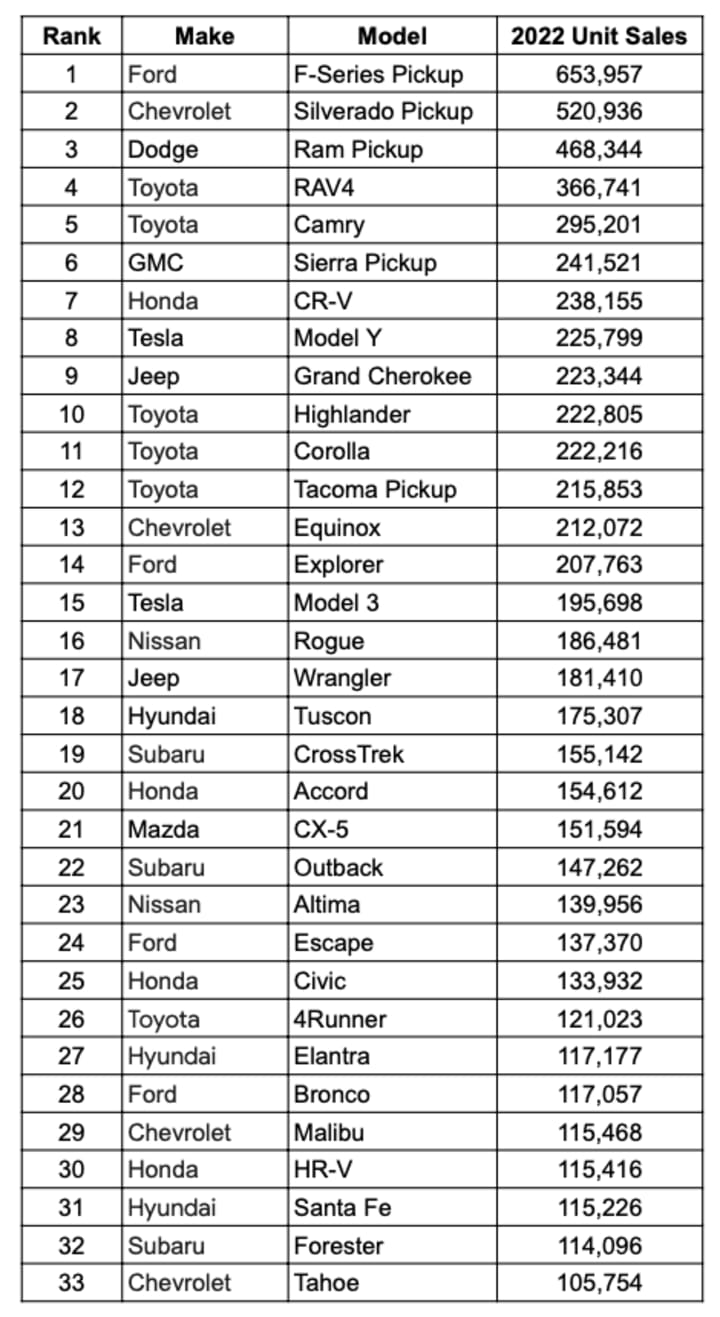
Source Data: Carscoops, These Are America’s Best Selling Cars And Trucks Of 2022, January 2023.
In Figure 2 (New Passenger Cars Sold in the United States, 1951-2022), you see a graphic put together by the outstanding data analysts at Statista. They looked at passenger car sales in the U.S. from 1951 to 2022. As the reader will note, sales of new passenger cars have clearly had their ups and downs, due to economic conditions, gas prices, and yes, consumer preferences, passenger cars. In fact, sales of “new cars” (2-door coupes and 4-door sedans) had dual peaks - in 1973 and 1986 - at 11.4 million units. As recently as 2014, 7.71 million new passenger cars were sold by dealers across the U.S. However, over the past decade, passenger car sales have been in a constant - and steep - decline. Last year (2022), passenger car sales stood at 2.86 million units, less than half of what they were in 2014 and less than a quarter of what they were at the 1973 and 1986 peaks.
Figure 2 - New Passenger Cars Sold in the United States, 1951-2022
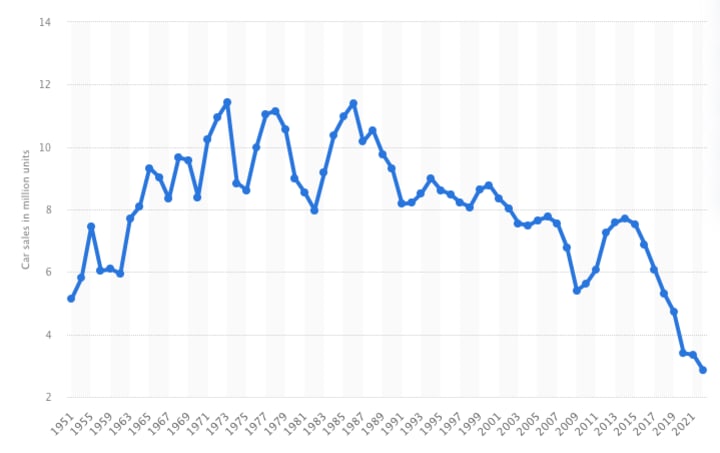
Source: Statista, Annual Passenger Car Sales in the United States from 1951 to 2022, August 2023 (Used with permission).
As Americans’ interest in traditional passenger cars has demonstrably and dramatically waned, trucks have now seemingly supplanted SUVs (sport utility vehicles) as the signature lines of the auto companies - both American and foreign alike. SUVs have been the growth segment of the new vehicle market over the past two decades for a variety of factors - including Americans’ lifestyles and relatively low gas prices. But today, again owing to a wide variety and confluence of factors that are beyond the scope of the present article, it is safe to say that there is a pickup truck for everyone’s lifestyle and needs available on the market today. Full-sized, gargantuan-sized, mid-sized, and now even compact trucks (like the Ford Ranger), the “car” companies now have a plethora of truck options available to consumers. And as you can see in Figure 3 (Annual Sales of New Midsize Trucks in the U.S., 2013-2022) below, while the “big boy” trucks - the Ford F Series, the Chevrolet Silverados, and the Dodge Rams - still dominate the truck market in total sales, there has been significant growth in the sales of smaller truck models - and the introduction of new truck concepts (such as the Jeep Gladiator and GMC Canyon) - in the U.S. market over the past decade.
Figure 3 - Annual Sales of New Midsize Trucks in the U.S., 2013-2022
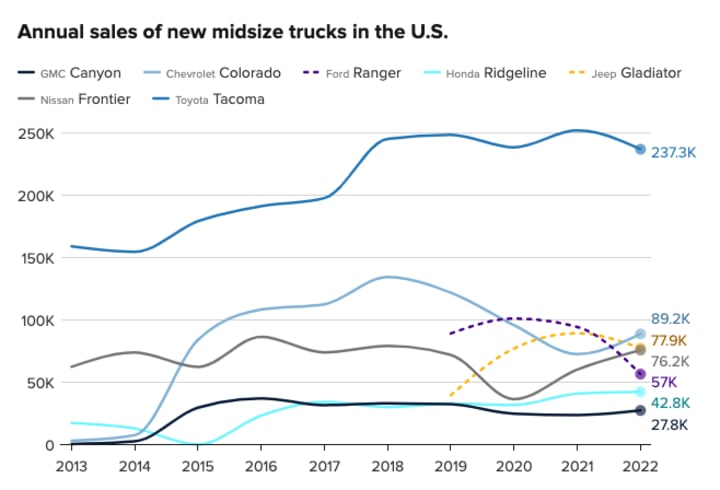
Source: CNBC, Ford, GM, and Toyota Push into Midsize Pickup Trucks, the Latest Battleground for U.S. Automakers, May 2023 (Used with permission).
Talk about a market transformation! The trendlines show that a very real and very important convergence is about to happen in what we have been referring to since Henry Ford’s days as the “automobile market.” This is because we are very near the point where the total number of new pickups sold will exceed the number of new 2-door coupes and 4-door sedans sold in the United States, likely somewhere around 2.7-2.8 million units and perhaps as early as next year (2024), when 2023’s total new vehicle sales numbers come in. The “car companies” are today fast becoming not just vehicle companies, but in essence, truck makers for “Pickup Truck Nation.”

So, in the final section of this article, we’ll explore what this means for these leading firms not just in the U.S. economy, but on the global stage as well - and what it might mean for you as an investor, as an employee, and as a stakeholder (and yes kids, broadly defined that means all of us today) as this transformation of this important, vital, and sprawling industry is happening in real-time!

Analysis
The evidence is clear. We are fast becoming not just a car-centric society in 98% of the United States. We are morphing - in real-time - into “Pickup Truck Nation!” The auto industry is now more and more the “truck industry” - and we - and their leaders - should think of it as such. No less a business magnate than Elon Musk - like him or hate him for what he has done with Twitter (or X) - has seen the light. The Tesla CEO has just announced that Tesla - yes, the pioneering electric car company - is about to become an electric truck company. Tesla will begin delivering the first of its Cybertrucks to customers later this month (November 2023), and the company plans on producing 200,000 trucks in 2024 and 250,000 in 2025. Assuming these production targets are reached and customers pay the $60-70,000 for the futuristically-styled Tesla pickup (a price point that would be less than that of the only other electrically-powered F-150 truck sold by Ford), this ambitious target would rank the Cybertruck among the top 10 vehicles sold in volume in the U.S.
So, the reality in the marketplace is that the American consumer has spoken.“Traditional” passenger cars are now considered almost passé - the stuff reserved for rental cars and massive corporate and U.S. government fleets. The 2-door coupe and 4-door sedan seem to be fast going the way of the Model T, as consumers' concept of the “ideal” vehicle for them is more and more an SUV - and increasingly a truck that is sized and outfitted for their unique needs. And with the rapid rise in truck sales, there will be more and more truck options introduced in the marketplace. Just as we now have “compact SUVs” - such as the Nissan Versa, the Ford Escape, the Subaru Crosstrek, and more - we will see even more variations of the pickup truck offered to consumers in the near future. The invisible hand of the marketplace is fast-changing the American vehicle market, and with the influence of the U.S. consumer’s preferences globally, the truck trend will surely spread globally as well.

Now there are certainly “speedbumps” along the way on the road to America becoming “Pickup Truck Nation” - obstacles that also may be seen not as threats, but as vast opportunities for the established automotive industry and for new, entrepreneurial-minded entrants as well. The main obstacle, as anyone who has shopped for or bought a pickup truck over the past few years knows, is affordability. As car prices have risen dramatically over the past few years, prices on pickup trucks have risen even faster! In fact, as of 2023, the average price of a new car today has reached almost $50,000 ($49,500 to be precise), and the average transaction price - not the sticker price, but the price actually paid by the truck buyer - has now topped $59,000! Trucks have evolved into the ultimate “cash cow” for the automakers - fueling their revenue and turbocharging profitability! In fact, the Boston Consulting Group (BTW, the firm that originated the very concept of a “cash cow!”) recently conducted an analysis showing that the F-Series pickup trucks generated 30% of Ford’s total automotive revenue in 2020 - $42 billion dollars in all. In fact, as a consumer product, Ford’s F-Series was the second leading revenue generator on the market today, only falling behind a little thing made by Apple called the iPhone, which generated $55 billion in revenue in 2020! But even as truck prices rise even faster than the general automotive market, the automakers are responding with new, innovative, and yes, smaller and less-expensive models. The challenge going forward will be how the major automotive companies can better cater to the value-conscious truck buyer, offering lower-cost alternatives to those who do not want - or need - a truly tech-tricked-out truck for their everyday needs.
And while there can be short-term shocks to the consumer truck market (i.e. inflation, interest rates, economic uncertainties, fuel prices, climate concerns, etc.), the general trend towards a more truck-focused - and fueled - automotive market seems to be taking hold, and even accelerating, with each passing year. America’s car companies are no longer really car companies. Even though the media and the general public refer to Ford, General Motors, Toyota, Nissan and the like as “carmakers,” they really are today not in the “car business,” but rather, in the “vehicle business.” The leaders of these firms globally seem to be adjusting to the fact that they are no longer primarily making gas-powered, traditional cars, but a whole range of vehicles powered by gas, electricity, and yes, even hydrogen.

Yes, trucks are a seemingly ever-increasing and important part of that product mix, and this trend shows no sign of abating. However, by focusing on being vehicle companies - even transportation companies - large automakers can have the nimbleness needed to succeed in what is a fast-changing automotive market. This will enable them to be flexible - both in mindset and in manufacturing - to be able to respond with the right product offerings as consumer preferences and needs are changing quicker than ever today.

No one 15-20 years ago would have predicted the ascendency of the pickup truck to the pinnacle of today’s automotive market, and likewise today, it would be foolish to say that in 2033 or 2043, pickups will still dominate the new vehicle market as they do today. The challenge for the executives of the major automotive companies - from Detroit to Seoul to Tokyo and beyond - is to be constantly listening - REALLY listening - to consumers to see and to anticipate “the next profound shift” will be in the automotive market.
But here in late 2023, we Americans are certainly living in what has become “Pickup Truck Nation!” And yes, we may be fast on the road to becoming a “Pickup Truck World “ - at least until the next BIG THING comes along! Buckle up, folks! As with all the twists and turns that have occurred in the over one hundred years of the automotive industry, the future promises to be a wild ride indeed!
+++++++++++++++++++++++++++++++++++++
About David Wyld
David Wyld is a Professor of Strategic Management at Southeastern Louisiana University in Hammond, Louisiana. He is a management consultant, researcher/writer, publisher, executive educator, and experienced expert witness. You can view all of his work at https://authory.com/DavidWyld. You can subscribe to his Medium article feed at: https://davidwyld.medium.com/subscribe.
Social Media Links to David Wyld:
* on Facebook
* on LinkedIn
* on Twitter (X)
About the Creator
David Wyld
Professor, Consultant, Doer. Founder/Publisher of The IDEA Publishing (http://www.theideapublishing.com/) & Modern Business Press (http://www.modernbusinesspress.com)


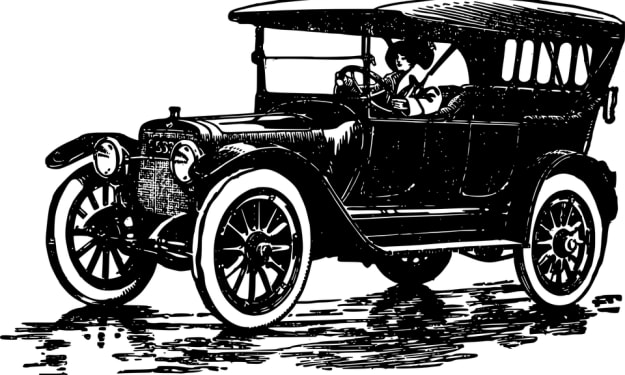



Comments (1)
Hi David - Certainly with the seat-belt laws the (4) door pickup is the new 'Utility' every day driver vehicle...But, try to find a 'Tush-Tickle' parking spot at the Walmart. 'j' in l.a.